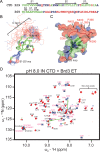Altering murine leukemia virus integration through disruption of the integrase and BET protein family interaction
- PMID: 24623816
- PMCID: PMC4027182
- DOI: 10.1093/nar/gku175
Altering murine leukemia virus integration through disruption of the integrase and BET protein family interaction
Abstract
We report alterations to the murine leukemia virus (MLV) integrase (IN) protein that successfully result in decreasing its integration frequency at transcription start sites and CpG islands, thereby reducing the potential for insertional activation. The host bromo and extraterminal (BET) proteins Brd2, 3 and 4 interact with the MLV IN protein primarily through the BET protein ET domain. Using solution NMR, protein interaction studies, and next generation sequencing, we show that the C-terminal tail peptide region of MLV IN is important for the interaction with BET proteins and that disruption of this interaction through truncation mutations affects the global targeting profile of MLV vectors. The use of the unstructured tails of gammaretroviral INs to direct association with complexes at active promoters parallels that used by histones and RNA polymerase II. Viruses bearing MLV IN C-terminal truncations can provide new avenues to improve the safety profile of gammaretroviral vectors for human gene therapy.
© The Author(s) 2014. Published by Oxford University Press on behalf of Nucleic Acids Research.
Figures





References
-
- Fischer A., Hacein-Bey-Abina S., Cavazzana-Calvo M. Gene therapy of primary T cell immunodeficiencies. Gene. 2013;525:170–173. - PubMed
-
- Hacein-Bey-Abina S., Von Kalle C., Schmidt M., McCormack M.P., Wulffraat N., Leboulch P., Lim A., Osborne C.S., Pawliuk R., Morillon E., et al. LMO2-associated clonal T cell proliferation in two patients after gene therapy for SCID-X1. Science. 2003;302:415–419. - PubMed
-
- Wu X., Li Y., Crise B., Burgess S.M. Transcription start regions in the human genome are favored targets for MLV integration. Science. 2003;300:1749–1751. - PubMed
Publication types
MeSH terms
Substances
Associated data
- Actions
Grants and funding
LinkOut - more resources
Full Text Sources
Other Literature Sources
Miscellaneous

